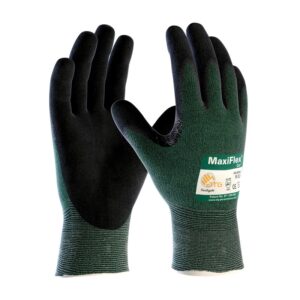Nearly everything that’s been invented, built, or written exists because of human hands. When you consider how important hands are, on both an individual and societal scale, keeping them protected is a paramount concern.
 Hand protection, specifically through the use of gloves, is critical in today’s manufacturing world. It can be a cost-effective way to increase safety, employee productivity, and morale. Regardless of the task at hand, there’s probably a glove that exists to make the job easier while protecting the wearer. But how do you know which glove is right for a specific job?
Hand protection, specifically through the use of gloves, is critical in today’s manufacturing world. It can be a cost-effective way to increase safety, employee productivity, and morale. Regardless of the task at hand, there’s probably a glove that exists to make the job easier while protecting the wearer. But how do you know which glove is right for a specific job?
This blog will explore how gloves are rated for their ability to provide resistance to cuts, abrasion, heat, puncture, and impact and detail how Agilix Solutions uses this information to help customers select the right gloves for their employees.
Cut Resistance Safety Ratings
Cut resistance is one of the most sought-after safety features in gloves. American National Standards Institute (ANSI) and the European Standard for Protecting Gloves (EN 388) both offer cut protection ratings. ANSI’s current standards were updated in 2017 and are is the preferred rating method for cut protection measurement in the United States. The EN rating uses a circular rotating razor blade and a consistent pressure to rate a flat piece of the material on how many rotations it takes to cut it. The ANSI measurement utilizes a flat razor blade to attempt 14 cuts on a rounded piece of material. Each time, a new razor blade is used to prevent dulling, and more pressure is exerted. The rating of the glove is determined by the lowest gram pressure that causes the material to fail.
The ANSI cut resistance scale previously had five levels. But as manufacturers have continuously advanced their cut resistance technology, ANSI recognized that there was becoming a higher range of cut performance at the fifth level. So, in 2017, new standards were developed to measure cut resistance performance on a 9-point scale.
Abrasion Resistance Safety Ratings
Abrasion, on the other hand, is one class of protection where the EN score is the industry-preferred standard. Abrasion resistance is measured on a 4-point scale. To measure it, a patch is cut out of the palm of the coating of a glove. Sandpaper is used at a consistent pressure on the material. The glove’s abrasion resistance is a measure of how many rotations it takes to get through the material.
Heat Resistance Safety Ratings
“Hot” is a relative term. Hot to a plastic extruder is different than it is to a metal extruder or a welder. As a result, two fundamental questions must be answered when evaluating your needs: (1) how hot is the area you need to touch? And (2) how long do you need to hold it?
ANSI tests for conductive heat resistance. The test they have developed scores materials on the highest contact temperature at which the material prevents a 2nd degree burn and the time to pain is less than four seconds. Materials are rated on a scale of 0-5, with 5 being the most heat resistant.
Puncture Resistance Safety Ratings
ANSI has two different puncture tests they administer depending on the intended application of the glove. The ASTM F 2878 needle test uses a hypodermic needle. The ASTM F 1342 puncture test uses a larger 2.07 mm test probe. EN 388 also administers a puncture test, but theirs uses a 4.5 mm test probe, slightly smaller than a standard pencil.
In all forms of puncture testing, the glove’s rating is based on a measurement of the number of pounds of pressure needed to puncture the glove. ANSI’s smaller probes are designed for gloves intended to protect against hypodermic needle puncture. Gloves meant to prevent larger punctures typically use the EN 388 test.
Impact Resistance Safety Ratings
Relative to the other resistance measurements, impact protection is relatively new. Manufacturers in recent years have been adding rubber to the backs of gloves and claiming it provides impact protection, but there was never really a standard by which to measure it.
To measure the impact performance of gloves, ANSI partnered with ISEA to develop a third-party verified series of 8 tests to measure minimum performance standards of an impact-rated glove. These tests feature a 5.5 lb. steel striker, travelling 4.4 mph, exerting 5 joules of force, to measure dissipative forces on knuckles and fingers. There are three levels of performance a glove can earn from level 1 (minimum standard) to level 3 (highest standard). For each performance rating, all 8 tests must fall within a specified mean and below a maximum impact rating.
Impact-rated gloves are more expensive than gloves that don’t protect for impact. But in some applications, they are critical. In scenarios that call for it, it doesn’t take long to see an investment in impact-rated gloves pay off.
Agilix Solutions Can Supply the Gloves for Your Application
Glove technology has advanced rapidly in recent years and Agilix Solutions can support your hand protection requirements. Through a wear trial, we allow you evaluate a glove solution that is safe and cost-effective, and that employees will want to wear.
Contact your Agilix Solutions Account Manager today, or reach out to your local branch to take the next step toward protecting your employees’ most valuable tools. Know what glove you need? Shop our online glove store today!
